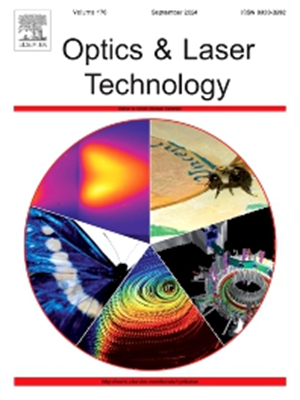Numerical simulation and experimental investigation of laser pulse duration effects on Ni/SiC ohmic contacts during ultraviolet laser annealing
IF 5
2区 物理与天体物理
Q1 OPTICS
引用次数: 0
Abstract
Silicon carbide (SiC) is considered as a competitive candidate for power semiconductor devices owing to its outstanding comprehensive properties. Laser annealing is an efficient method for preparing Ni/SiC ohmic contact, which is essential for optimizing the performance of SiC-based devices. However, to the best of our knowledge, the impact of laser pulse duration on Ni/SiC contact properties has not been systematically studied yet. Here, we report an ohmic contact engineering of SiC wafer to reveal the specific correlation between pulse durations and ohmic contact characteristics. A transient heat transfer model was established using COMSOL Multiphysics to simulate the temperature dynamic evolution under varying pulse durations, revealing that shorter pulse durations generate higher peak temperatures. Experimental studies were carried out by annealing Ni/SiC samples with pulse durations of 70 ns, 90 ns, and 110 ns, followed by analyses of surface morphology, interfacial microstructure, and electrical characteristics of the contacts. The results show that the surface roughness increases as the pulse duration decreases, the alloyed interface layer becomes thick, and the alloy phase shifts toward a Si-rich composition. Specific contact resistances on the order of 10-4 Ω∙cm2 were observed for all pulse durations, owing to the formation of uniform interface structures. The formation mechanism of ohmic contacts was further discussed based on energy band theory. This study highlights the potential of optimizing laser pulse duration to improve ohmic contact performance and offers valuable insights for the design and fabrication of SiC-based devices.
紫外激光退火过程中激光脉冲时间对Ni/SiC欧姆接触影响的数值模拟与实验研究
碳化硅(SiC)由于其优异的综合性能而被认为是功率半导体器件的有力候选材料。激光退火是制备Ni/SiC欧姆触点的有效方法,对优化SiC基器件的性能至关重要。然而,据我们所知,激光脉冲持续时间对Ni/SiC接触性能的影响还没有系统的研究。在此,我们报告了SiC晶圆的欧姆接触工程,以揭示脉冲持续时间与欧姆接触特性之间的特定相关性。利用COMSOL Multiphysics建立了瞬态传热模型,模拟了不同脉冲持续时间下的温度动态演化,发现脉冲持续时间越短,峰值温度越高。实验研究采用脉冲时间分别为70、90和110 ns的Ni/SiC样品进行退火,分析了表面形貌、界面微观结构和触点的电特性。结果表明:随着脉冲持续时间的减小,合金表面粗糙度增大,合金界面层变厚,合金相向富硅成分转变;在所有脉冲持续时间内,由于形成了均匀的界面结构,观察到的比接触电阻为10-4 Ω∙cm2。基于能带理论进一步探讨了欧姆接触的形成机理。该研究强调了优化激光脉冲持续时间以改善欧姆接触性能的潜力,并为sic基器件的设计和制造提供了有价值的见解。
本文章由计算机程序翻译,如有差异,请以英文原文为准。
求助全文
约1分钟内获得全文
求助全文
来源期刊
CiteScore
8.50
自引率
10.00%
发文量
1060
审稿时长
3.4 months
期刊介绍:
Optics & Laser Technology aims to provide a vehicle for the publication of a broad range of high quality research and review papers in those fields of scientific and engineering research appertaining to the development and application of the technology of optics and lasers. Papers describing original work in these areas are submitted to rigorous refereeing prior to acceptance for publication.
The scope of Optics & Laser Technology encompasses, but is not restricted to, the following areas:
•development in all types of lasers
•developments in optoelectronic devices and photonics
•developments in new photonics and optical concepts
•developments in conventional optics, optical instruments and components
•techniques of optical metrology, including interferometry and optical fibre sensors
•LIDAR and other non-contact optical measurement techniques, including optical methods in heat and fluid flow
•applications of lasers to materials processing, optical NDT display (including holography) and optical communication
•research and development in the field of laser safety including studies of hazards resulting from the applications of lasers (laser safety, hazards of laser fume)
•developments in optical computing and optical information processing
•developments in new optical materials
•developments in new optical characterization methods and techniques
•developments in quantum optics
•developments in light assisted micro and nanofabrication methods and techniques
•developments in nanophotonics and biophotonics
•developments in imaging processing and systems

 求助内容:
求助内容: 应助结果提醒方式:
应助结果提醒方式:


